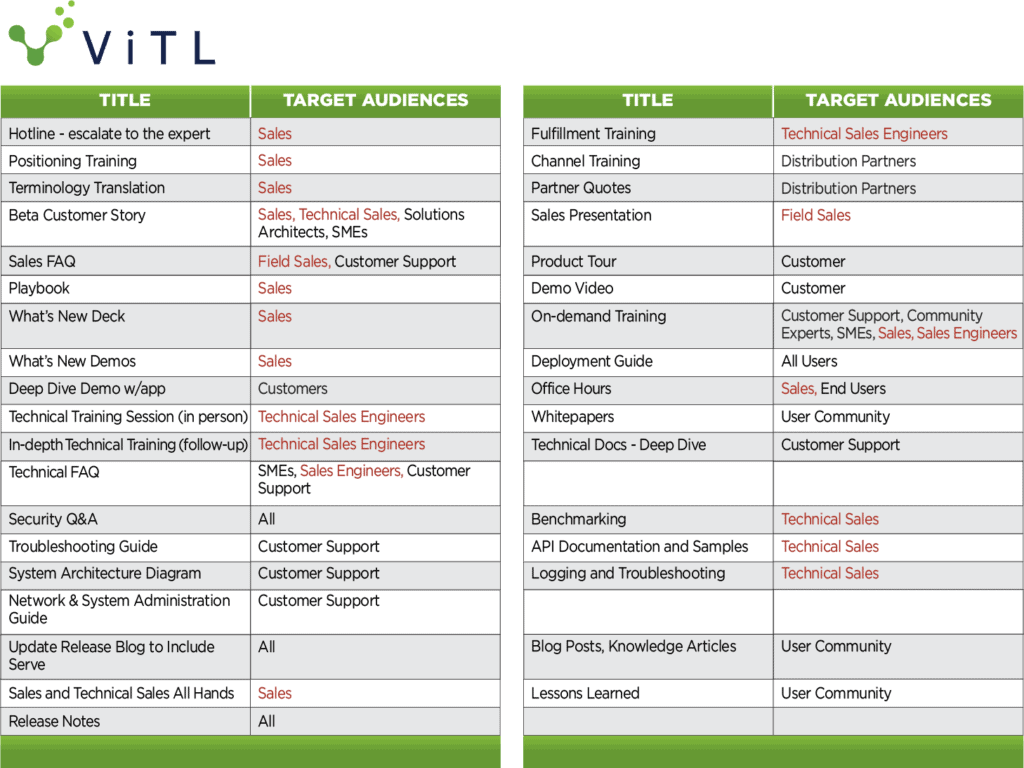Imagine this… a new version of your smart phone comes out with about a thousand new features. Did you go to a classroom to learn how to use it? My guess is no. Did you receive a personal email with instructions for each new feature? Probably not. Did you watch videos? Maybe! Did you use your phone and find helpful new hints each time you opened a new app? Or did you just learn the system by trial and error? Or even better, maybe you were you like me. I learned new features from watching my four- and seven-year-old children play with it. They’re already smarter than I am!
Bottom line, you must know your audience(s). First, how do they learn? There are debates about how many different learning types there are. The one I particularly align with is VARK. This is summarized nicely by a previous blog article by Chelsi Nakano at Prezi.
| Term | Description | Tactics for facilitation |
|---|---|---|
| Visual | Prefer to see info and visualize the relationships between ideas | Provide charts and graphics. Make your presentations highly visual and clearly articulate the relationships between your various points |
| Auditory | Prefer to hear info rather than reading it or seeing it displayed visually | Auditory learners like to recite information out loud to remember it. Give them a chance to repeat your points back to you by asking questions and calling for audience answers |
| Reading / Writing | Learn best when reading and writing. Interacting with text is more powerful for these learners than hearing or seeing images | Give these learners written quizzes that give them a chance to write down what they have learned. Provide annotated handouts of the presentation so that they can read along |
| Kinesthetic | Hands on, experimental learners who learn best by doing | Provide exercises that give these learners the opportunity to stand up and move around in order to demonstrate or experience certain points (e.g., role playing) |
To add on to this, do your audiences prefer to learn in a social or a solitary setting? Meaning, do they learn best by dialoguing and interacting with other people? Or, do they need a quiet and secluded location to absorb the information?
Next, consider your audience’s demographics and accessibilities.
- Where are your audiences impacted by the change located? Are they all centrally co-located or geographically dispersed? Is it feasible to think that they will be able to physically sit in a classroom together to learn about the change that you are facilitating? For these audiences, you may need to consider delivering training via a video or webinar. Other approaches may include a “train the trainer” approach to train a smaller group in a single location that can then enable geographically dispersed audiences to be successful with the change.
- Does your audience all have access to a home computer and do they all have the same technology capabilities? Also, is there an expectation that they will do training at home or only in the environment in which the change is occurring?
- Does your audience speak the same language?
- Is your audience relatively the same age? (Albeit a generalization that I hope is not perceived or projected as a bias, different generations will likely have different capabilities when exposed to different technologies or learning environments, just as I mentioned earlier with my four- and seven-year-old kiddos.)
All of these considerations are necessary to take into account when you develop your Training Plan. Below outlines the typical categories we include at ViTL Solutions when developing a training plan for organizational changes:
- Target Audience
- Training Title
- Description
- Messaging
- Required Outcomes
- Content Type
- Communication Vehicle / Delivery Forum
- Training Requirements & Dependencies
- Content Creation Responsibility (Who?)
- Content Delivery Responsibility (Who?)
- Training Logistics
- Start
- Finish
- Delivery Dates
- Status
- Feedback / Lessons Learned
As outlined, start first with the target audience. Without defining the audience first, it’s possible to miss the mark on successful change adoption. Additionally, consider listing the same target audience multiple times outlining different delivery approaches (e.g., online computer-based training “CBT,” email communication with embedded step action, webinars, video, etc.)
For example, ViTL Solutions recently supported an organization with their readiness for a new product launch. Below is a snapshot of the knowledge toolkit artifacts needed to enable the audiences (internal and external) impacted by the product launch. As highlighted, the Sales teams benefit by being exposed to a variety of materials and teaching approaches to learn about the change so that they can then educate and sell to end users.

So, the next time you decide to implement a change, consider the following:
- Who is your audience? (Note: if you’re stuck with defining your audience, read the identifying your stakeholders blog.)
- How will they be exposed to the change and what learning styles do they best associate with? (Note: it’s likely that there will be a blend of all the learning styles.)
- What are their demographics and accessibility considerations?
This approach applies to any type of change, including process optimizations, product launches, system implementations, and more.



